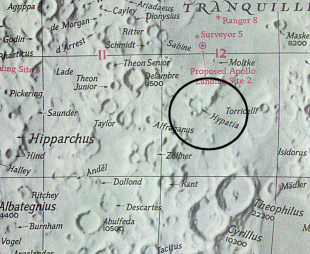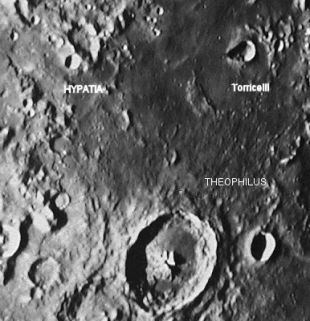

Hypatia Ray (as reported by Akkana Peck)
Hypatia has a break in its eastern wall, and at about 8pm PST (on 3/4/98), a thin ray was just beginning to spill through the gap in the wall and all the way across the crater floor to the other side, where another break in the wall, just south of where the ray ended, created a second ray streaming out of Hypatia onto the terrain west of the crater. It was a lovely sight -- the best lunar ray I've observed so far.
Ray was observed on March 4, 1998 local at 8:00 PM which is March 5, 1998, 3:00 UT. Akkana's coordinates are approximately 122.3W, 37.6N. By running predictions using site coordinates, date and time of the event, it was determined that the event could be seen when the sun was 13.116 degrees rising, with an average colongitude of 350.554 degrees. This data was used to compute the predictions, found on the prediction page.
Site Longitude = +122.300
Site Latitude = +37.600
Feature = HYPATIA
Feature Longitude: = +22.600
Feature Latitude: = -4.300
Reproducing Lighting For: 1998/3/5 at 03:00 U.T.
Desired Solar Altitude = +13.116(Rising), Azimuth = +89.109
Average Co-longitude = 350.554
In the Time column, D=Daylight, T=Twilight
---- Moon's ---- -- Earth's --
Topocentric Topocentric -------- Sun's --------
UT Date Time Alt° Semi-Diam'' Long° Lat° Colong° Lat° Azim°
1998/03/05 03:00T +65.532 964.65 +6.368 +7.173 350.545 -0.110 +89.109
HYPATIA, +381,-070: A remarkable formation, distinctly triangular and 30 miles in diameter. The walls rise 7,000 feet on the east, while there is a deep crater, A, on the south-east wall. On the west there are gaps in the wall, which is also low on the north. On the floor is some faint detail, including a hill. To the north-west is a great rocky mass, and on the north-east a mass of craters of which F and K are the deepest. To the west are isolated hills running north and south. On the north is a ring, F, containing a central crater. - Wilkins and Moore, The Moon, Faber and Faber, 1955

